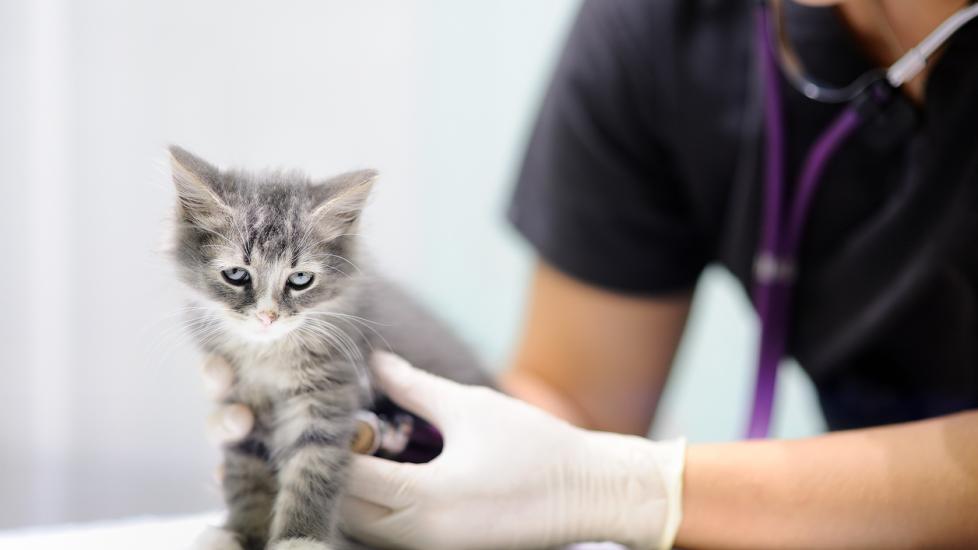Pectus Excavatum in Cats
What Is Pectus Excavatum in Cats?
Pectus excavatum, Latin for “hollow breast,” describes a chest wall deformity where the rib cartilage and sternum (chest bone) are not formed correctly. This condition may also be called flat-chested syndrome in kittens, or funnel chest. It is an extremely rare condition in cats.
This congenital (present from birth) defect occurs during fetal development and results in the ribs and sternum not forming properly. The result is a concave or sunken chest wall, starting at approximately the third to fifth rib and extending to the tip of the sternum. The abnormally shaped chest space causes the heart to be moved to the left side of the chest cavity, causing squeezing of the right side of the heart. Parts of the lungs are also squeezed, resulting in decreased lung function.
Although kittens are born with this defect, clinical symptoms are not always noticed right away. Mild symptoms can worsen as the kitten grows, but once growth is done, any symptoms already present tend to settle at a certain level. In severe cases, breathing or heart problems can occur from a very young age.
Symptoms of Pectus Excavatum in Cats
While some kittens with pectus excavatum may appear normal, symptoms may include:
- Palpable concavity of the chest wall
- Trouble breathing
- Increased breathing rate
- Failure to thrive or inadequate growth rate
- Coughing
- Increased heart rate
- Cyanosis (blue-tinted skin from lack of oxygen)
- Heart murmur
- Exercise intolerance
Causes of Pectus Excavatum in Cats
The exact cause of pectus excavatum in cats is unknown. Because pectus excavatum is a congenital defect (occurring in the growing fetus), genetic factors may be at play. Bengal and Burmese cat breeds seem to have a predisposition to developing pectus excavatum.
How Veterinarians Diagnose Pectus Excavatum in Cats
Pectus excavatum is often diagnosed during a physical exam and feeling of the chest wall. X-rays and a CT scan of the chest can be done to confirm the diagnosis and find the severity of the problem. The CT scan can be particularly useful in showing the amount the heart has been moved (and potential heart dysfunction), which doesn’t always match the amount of skeletal deformity.
Other congenital defects can occur along with pectus excavatum and may need echocardiography or other testing.
Treatment of Pectus Excavatum
In cats not showing symptoms, treatment may not be necessary, but for patients showing clinical symptoms, treatment of pectus excavatum involves surgical repair of the chest wall deformity. Surgical repair is most often done by a surgical specialist at either a veterinary medical school or specialty referral hospital.
There are three types of surgical repair: external splinting, internal splinting, and a combination of external splinting combined with pinning of the sternum.
The external splinting technique is recommended for symptomatic kittens whose bones and cartilage of the chest are still flexible. External splinting involves using stitches to attach a splint to the chest wall. The splint then applies gentle and constant force to the sternum to correct the deformity. The splint is worn for four to eight weeks. If external splinting doesn’t fix the problem, internal splinting is recommended.
Internal splinting involves inserting a plate in the cat’s body, attaching it to the inside of the sternum. The plate can act as a bridge between the deformed and nondeformed parts of the sternum. The plate helps move the deformed sternum ventrally (outward), to allow for a normal increase of space in the chest cavity, and to fix any heart displacement. In some cases, muscle attachments or pieces of bone or cartilage may need to be removed to help with plate placement and sternal repositioning. A chest tube manages air and fluid buildup in the chest cavity during the recovery process. Because of the invasiveness of the surgery, recovery involves 24-hour monitoring in an intensive care unit where the patient is given IV fluids, antibiotics, and pain medication. The cat is also watched for post-operative breathing and heart complications.
A combination of internal surgery followed by external splinting may be required for some patients.
Recovery and Management of Pectus Excavatum in Cats
Recovery and management of pectus excavatum depends on the severity of the abnormality and what methods were used for repair. During recovery, pain medications are given to keep the cat comfortable. Antibiotics may also be used to prevent or treat infection.
External splints are worn for four to eight weeks, and the cat is examined weekly to make sure they are healing well. X-rays are also taken periodically to check the patient’s progress.
Pectus Excavatum in Cats FAQs
Can pectus excavatum in cats go away on its own?
Unfortunately, no. Cats who show symptoms need surgery to recover.
What happens if pectus excavatum in cats is left untreated?
In asymptomatic cats, treatment may not be necessary. However, asymptomatic patients should be watched closely for clinical symptoms. In cats who show symptoms of heart or lung problems, failure to treat pectus excavatum could result in severe illness or death.
Featured image: iStock.com/SbytovaMN
References
External Splinting for Pectus Excavatum in Kittens. www.cliniciansbrief.com. Accessed July 19, 2023. https://www.cliniciansbrief.com/article/external-splinting-pectus-excavatum-kittens
Pectus Excavatum in Puppies and Kittens. MSPCA-Angell. Accessed December 15, 2022. https://www.mspca.org/angell_services/pectus-excavatum-in-puppies-and-kittens/
Yoon HY, Mann FA, Jeong S. Surgical correction of pectus excavatum in two cats. Journal of Veterinary Science. 2008;9(3):335. doi: https://www.ncbi.nlm.nih.gov/pmc/articles/PMC2811848/
Risselada M, Rooster H de, Liuti T, Polis I, Bree H van. Use of internal splinting to realign a noncompliant sternum in a cat with pectus excavatum. Journal of the American Veterinary Medical Association. 2006;228(7):1047-1052. doi: https://avmajournals.avma.org/view/journals/javma/228/7/javma.228.7.1047.xml
